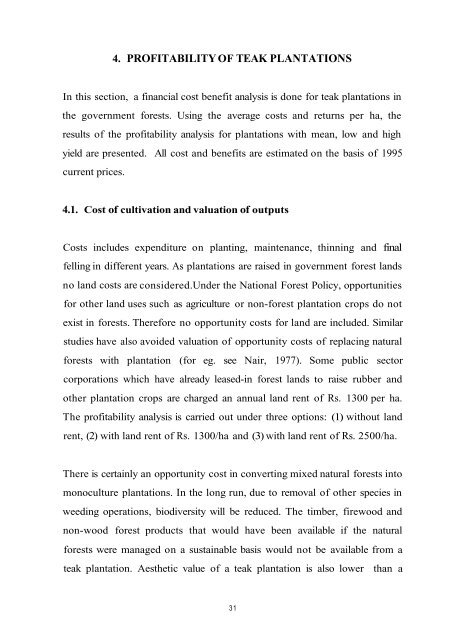TEAK PLANTATIONS IN NILAMBUR - Kerala Forest Research Institute
TEAK PLANTATIONS IN NILAMBUR - Kerala Forest Research Institute
TEAK PLANTATIONS IN NILAMBUR - Kerala Forest Research Institute
Create successful ePaper yourself
Turn your PDF publications into a flip-book with our unique Google optimized e-Paper software.
4. PROFITABILITY OF <strong>TEAK</strong> <strong>PLANTATIONS</strong><br />
In this section, a financial cost benefit analysis is done for teak plantations in<br />
the government forests. Using the average costs and returns per ha, the<br />
results of the profitability analysis for plantations with mean, low and high<br />
yield are presented. All cost and benefits are estimated on the basis of 1995<br />
current prices.<br />
4.1. Cost of cultivation and valuation of outputs<br />
Costs includes expenditure on planting, maintenance, thinning and final<br />
felling in different years. As plantations are raised in government forest lands<br />
no land costs are considered. Under the National <strong>Forest</strong> Policy, opportunities<br />
for other land uses such as agriculture or non-forest plantation crops do not<br />
exist in forests. Therefore no opportunity costs for land are included. Similar<br />
studies have also avoided valuation of opportunity costs of replacing natural<br />
forests with plantation (for eg. see Nair, 1977). Some public sector<br />
corporations which have already leased-in forest lands to raise rubber and<br />
other plantation crops are charged an annual land rent of Rs. 1300 per ha.<br />
The profitability analysis is carried out under three options: (1) without land<br />
rent, (2) with land rent of Rs. 1300/ha and (3) with land rent of Rs. 2500/ha.<br />
There is certainly an opportunity cost in converting mixed natural forests into<br />
monoculture plantations. In the long run, due to removal of other species in<br />
weeding operations, biodiversity will be reduced. The timber, firewood and<br />
non-wood forest products that would have been available if the natural<br />
forests were managed on a sustainable basis would not be available from a<br />
teak plantation. Aesthetic value of a teak plantation is also lower than a<br />
31

















